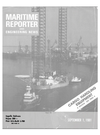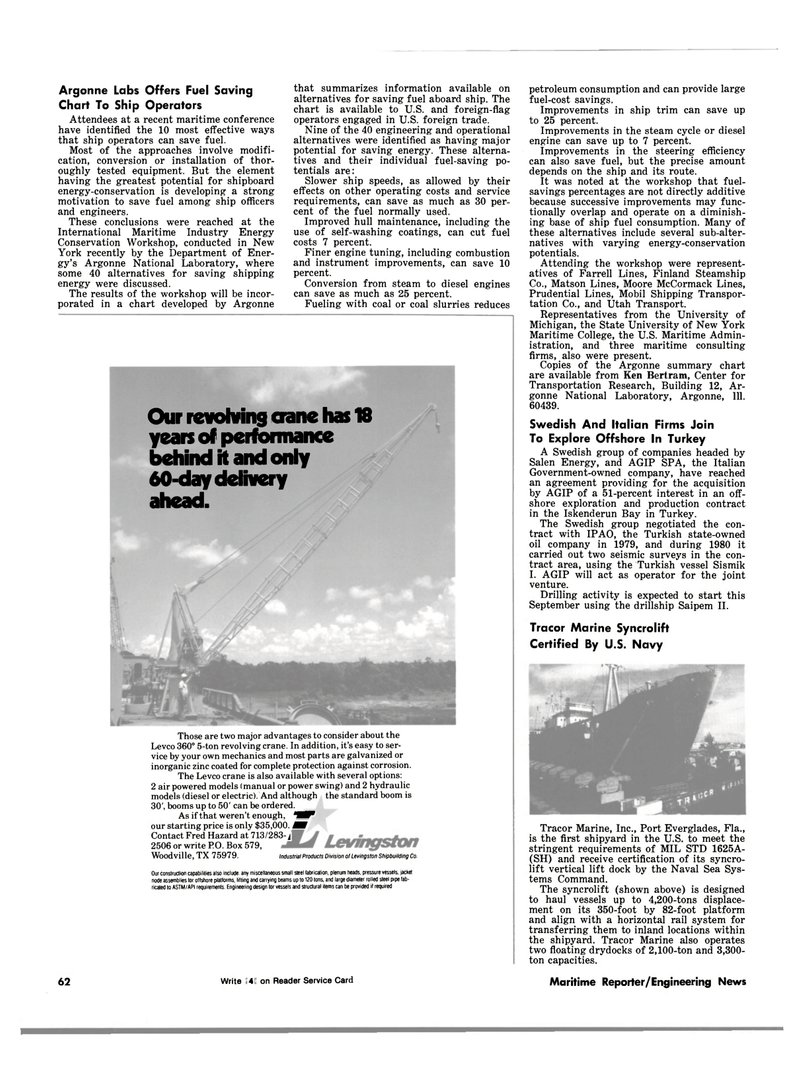
Page 3rd Cover: of Maritime Reporter Magazine (September 1981)
Read this page in Pdf, Flash or Html5 edition of September 1981 Maritime Reporter Magazine
Argonne Labs Offers Fuel Saving
Chart To Ship Operators
Attendees at a recent maritime conference have identified the 10 most effective ways that ship operators can save fuel.
Most of the approaches involve modifi- cation, conversion or installation of thor- oughly tested equipment. But the element having the greatest potential for shipboard energy-conservation is developing a strong motivation to save fuel among ship officers and engineers.
These conclusions were reached at the
International Maritime Industry Energy
Conservation Workshop, conducted in New
York recently by the Department of Ener- gy's Argonne National Laboratory, where some 40 alternatives for saving shipping energy were discussed.
The results of the workshop will be incor- porated in a chart developed by Argonne that summarizes information available on alternatives for saving fuel aboard ship. The chart is available to U.S. and foreign-flag operators engaged in U.S. foreign trade.
Nine of the 40 engineering and operational alternatives were identified as having major potential for saving energy. These alterna- tives and their individual fuel-saving po- tentials are:
Slower ship speeds, as allowed by their effects on other operating costs and service requirements, can save as much as 30 per- cent of the fuel normally used.
Improved hull maintenance, including the use of self-washing coatings, can cut fuel costs 7 percent.
Finer engine tuning, including combustion and instrument improvements, can save 10 percent.
Conversion from steam to diesel engines can save as much as 25 percent.
Fueling with coal or coal slurries reduces petroleum consumption and can provide large fuel-cost savings.
Improvements in ship trim can save up to 25 percent.
Improvements in the steam cycle or diesel engine can save up to 7 percent.
Improvements in the steering efficiency can also save fuel, but the precise amount depends on the ship and its route.
It was noted at the workshop that fuel- savings percentages are not directly additive because successive improvements may func- tionally overlap and operate on a diminish- ing base of ship fuel consumption. Many of these alternatives include several sub-alter- natives with varying energy-conservation potentials.
Attending the workshop were represent- atives of Farrell Lines, Finland Steamship
Co., Matson Lines, Moore McCormack Lines,
Prudential Lines, Mobil Shipping Transpor- tation Co., and Utah Transport.
Representatives from the University of
Michigan, the State University of New York
Maritime College, the U.S. Maritime Admin- istration, and three maritime consulting firms, also were present.
Copies of the Argonne summary chart are available from Ken Bertram, Center for
Transportation Research, Building 12, Ar- gonne National Laboratory, Argonne, 111. 60439.
Swedish And Italian Firms Join
To Explore Offshore In Turkey
A Swedish group of companies headed by
Salen Energy, and AGIP SPA, the Italian
Government-owned company, have reached an agreement providing for the acquisition by AGIP of a 51-percent interest in an off- shore exploration and production contract in the Iskenderun Bay in Turkey.
The Swedish group negotiated the con- tract with IPAO, the Turkish state-owned oil company in 1979, and during 1980 it carried out two seismic surveys in the con- tract area, using the Turkish vessel Sismik
I. AGIP will act as operator for the joint venture.
Drilling activity is expected to start this
September using the drillship Saipem II.
Tracor Marine Syncrolift
Certified By U.S. Navy
Tracor Marine, Inc., Port Everglades, Fla., is the first shipyard in the U.S. to meet the stringent requirements of MIL STD 1625A- (SH) and receive certification of its syncro- lift vertical lift dock by the Naval Sea Sys- tems Command.
The syncrolift (shown above) is designed to haul vessels up to 4,200-tons displace- ment on its 350-foot by 82-foot platform and align with a horizontal rail system for transferring them to inland locations within the shipyard. Tracor Marine also operates two floating drydocks of 2,100-ton and 3,300- ton capacities.
Our revolving crane has 18 years of performance behind it and only 60-day delivery ahead.
Those are two major advantages to consider about the
Levco 360° 5-ton revolving crane. In addition, it's easy to ser- vice by your own mechanics and most parts are galvanized or inorganic zinc coated for complete protection against corrosion.
The Levco crane is also available with several options: 2 air powered models (manual or power swing) and 2 hydraulic models (diesel or electric). And although the standard boom is 30', booms up to 50' can be ordered.
As if that weren't enough, our starting price is only $35,000.
Contact Fred Hazard at 713/283- j 2506 or write PO. Box 579,
Woodville, TX 75979. Industrial Products Division olLivingston Shipbuilding Co. 3 red. h, w on .m
Our construction capabilities also include, any miscellaneous small steel fabrication, plenum heads, pressure vessels, jacket node assemblies tor offshore platforms, lilting and carrying beams up to 120 tons, and large diameter rolled steel pipe fab- ricated to ASTM/API requirements. Engineering design tor vessels and structural items can be provided it required 62 Write 147 on Reader Service Card Maritime Reporter/Engineering News

 59
59

 4th Cover
4th Cover
